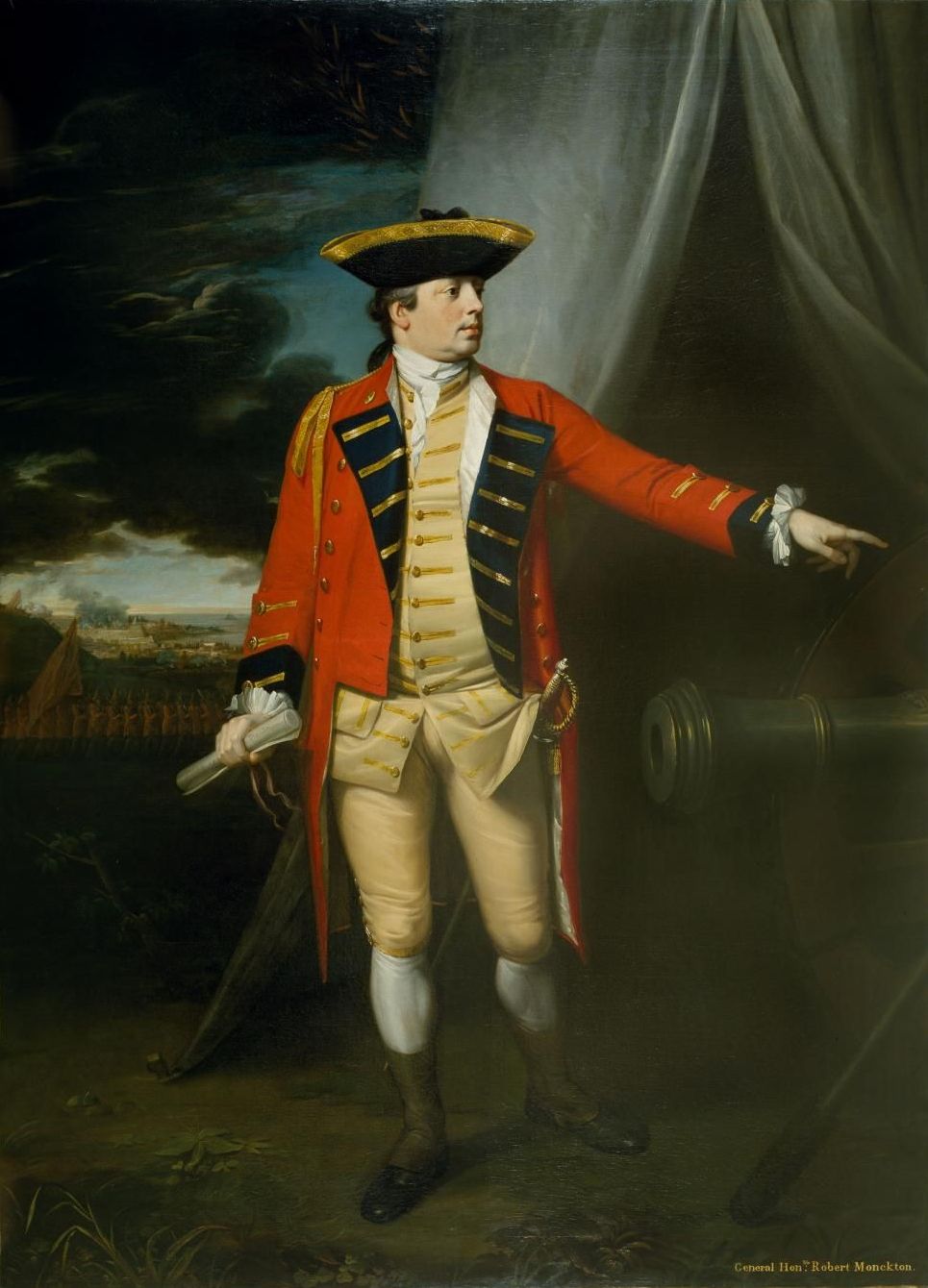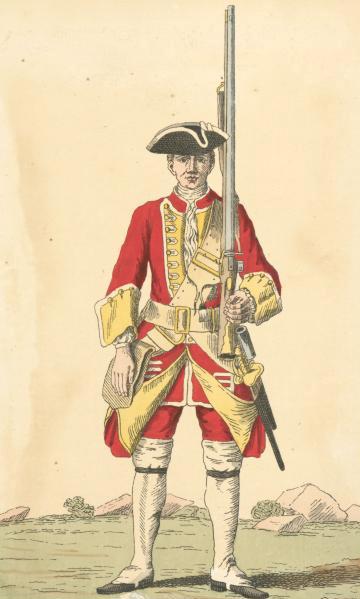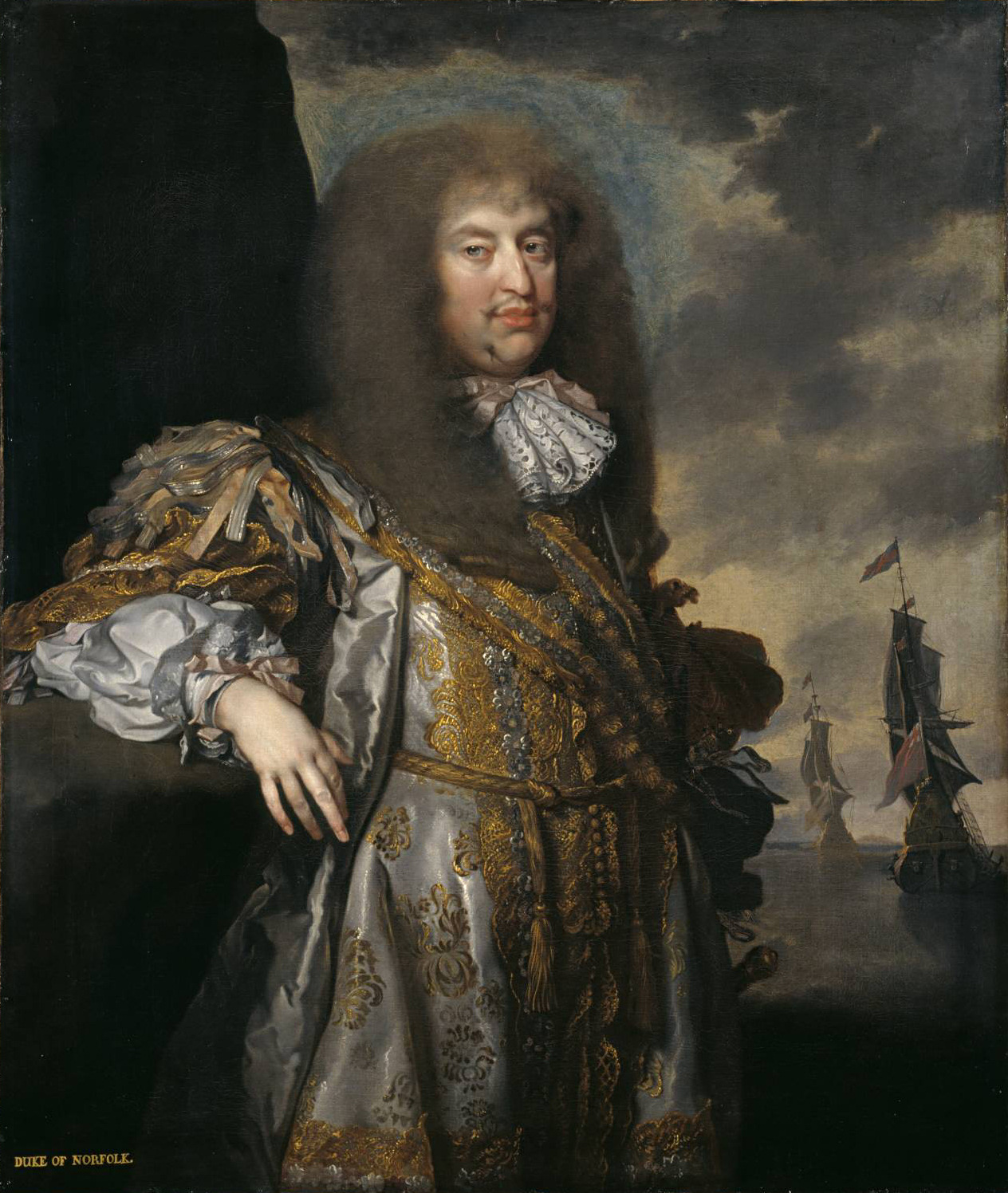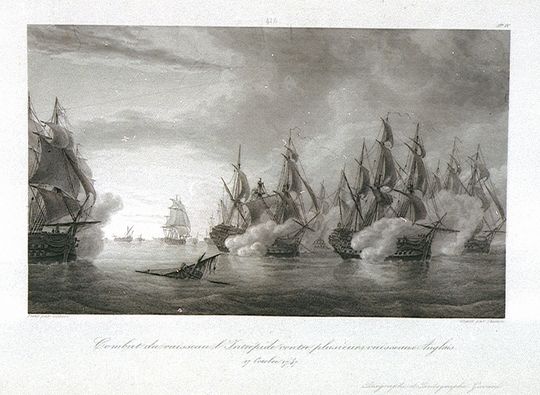|
Invasion Of Martinique (1762)
The British expedition against Martinique was a military action that took place in January and February 1762. It was part of the Seven Years' War. Background After the surrender of Dominica to a British expeditionary force, the French in Martinique fully expected the same expedition to head into their direction. Accordingly, they took measures for their defense. The French force in Martinique consisted of 1,200 regulars, 7,000 local militia and 4,000 hired privateersmen. Furthermore, the mountainous nature of the island made it rather easy to defend. The neighbouring British islands did what they could to help the mother-country: * Antigua sent blacks and part of her old garrison, the 38th Regiment of Foot, which had not left her since Queen Anne's day; * Barbados raised 500 black and 500 white men, which were the more acceptable since that island was the rendezvous for the expedition. The first troops to arrive in Carlisle Bay were a detachment from Belle-Isle, Newfoundlan ... [...More Info...] [...Related Items...] OR: [Wikipedia] [Google] [Baidu] |
Seven Years' War
The Seven Years' War (1756–1763) was a global conflict that involved most of the European Great Powers, and was fought primarily in Europe, the Americas, and Asia-Pacific. Other concurrent conflicts include the French and Indian War (1754–1763), the Carnatic Wars and the Anglo-Spanish War (1762–1763). The opposing alliances were led by Great Britain and France respectively, both seeking to establish global pre-eminence at the expense of the other. Along with Spain, France fought Britain both in Europe and overseas with land-based armies and naval forces, while Britain's ally Prussia sought territorial expansion in Europe and consolidation of its power. Long-standing colonial rivalries pitting Britain against France and Spain in North America and the West Indies were fought on a grand scale with consequential results. Prussia sought greater influence in the German states, while Austria wanted to regain Silesia, captured by Prussia in the previous war, and to contain Pruss ... [...More Info...] [...Related Items...] OR: [Wikipedia] [Google] [Baidu] |
69th Regiment Of Foot
The 69th (South Lincolnshire) Regiment of Foot was an infantry regiment of the British Army, raised in 1756. Under the Childers Reforms it amalgamated with the 41st (Welch) Regiment of Foot to form the Welch Regiment in 1881. History Formation The formation of the regiment was prompted by the expansion of the army as a result of the commencement of the Seven Years' War. On 25 August 1756 it was ordered that a number of existing regiments should raise a second battalion; among those chosen was the 24th Regiment of Foot. The 2nd Battalion of the 24th Regiment of Foot was formed on 10 December 1756 and renumbered as the 69th Regiment of Foot on 21 April 1758. The regiment took part in the Raid on St Malo in June 1758 and then formed part of a force which successfully captured Belle Île in spring 1761. It embarked for the West Indies later that year and took part in the Invasion of Martinique in January 1762 before returning home in 1763. The regiment returned to the West Indies in N ... [...More Info...] [...Related Items...] OR: [Wikipedia] [Google] [Baidu] |
42nd Regiment Of Foot
The 42nd (Royal Highland) Regiment of Foot was a Scottish infantry regiment in the British Army also known as the Black Watch. Originally titled Crawford's Highlanders or the Highland Regiment and numbered 43rd in the line, in 1748, on the disbanding of Oglethorpe's Regiment of Foot, they were renumbered 42nd and in 1751 formally titled the 42nd (Highland) Regiment of Foot. The 42nd Regiment was one of the first three Highland Regiments to fight in North America. In 1881 the regiment was named ''The Royal Highland Regiment (The Black Watch)'', being officially redesignated ''The Black Watch (Royal Highland Regiment)'' in 1931. In 2006 the Black Watch became part of the ''Royal Regiment of Scotland''. History Early history After the Jacobite rising of 1715 the British government did not have the resources or manpower to keep a standing army in the Scottish Highlands. As a result, they were forced to keep order by recruiting men from local Highland clans that had been loya ... [...More Info...] [...Related Items...] OR: [Wikipedia] [Google] [Baidu] |
40th Regiment Of Foot
The 40th (the 2nd Somersetshire) Regiment of Foot was an infantry regiment of the British Army, raised in 1717 in Annapolis Royal, Nova Scotia. Under the Childers Reforms it amalgamated with the 82nd Regiment of Foot (Prince of Wales's Volunteers) to form the Prince of Wales's Volunteers (South Lancashire Regiment) in 1881. History Formation The regiment was raised at Annapolis Royal in Nova Scotia by General Richard Philipps as the Richard Philipps's Regiment of Foot in August 1717 out of independent companies stationed in North America and the West Indies. Father Rale's War Prior to Father Rale's War, the Mi'kmaq responded to the establishment of a British fort at Canso, Nova Scotia by raiding the settlement's fishing station in 1720. Phillips sent a company of the 40th, under the command of Major Lawrence Armstrong, to take up garrison of a small fort in Canso built by a group of New England fishermen. The Mi'kmaq continued preying on nearby shipping, forcing the garris ... [...More Info...] [...Related Items...] OR: [Wikipedia] [Google] [Baidu] |
35th Regiment Of Foot
The 35th (Royal Sussex) Regiment of Foot was an infantry regiment of the British Army, raised in 1701. Under the Childers Reforms it amalgamated with the 107th (Bengal Infantry) Regiment of Foot to form the Royal Sussex Regiment in 1881. History Formation The regiment was raised in Belfast by Arthur Chichester, 3rd Earl of Donegall as the Earl of Donegall's Regiment of Foot or the Belfast Regiment on 28 June 1701 to fight in the War of the Spanish Succession. This was the second raising of the Earl of Donegall's Regiment: the previous regiment was raised in 1693 and disbanded on 8 February 1697: despite the names there was no lineal connection between them.Swinson, p. 132Trimen, p. 1 The regiment was a strongly Protestantism, Protestant unit tasked with resisting the spread of Catholic Church, Roman Catholicism in Britain. William III of England, King William III, gave special permission for the regiment to bear orange facings to show their religious allegiance and as a mark of ... [...More Info...] [...Related Items...] OR: [Wikipedia] [Google] [Baidu] |
28th Regiment Of Foot
The 28th (North Gloucestershire) Regiment of Foot was a line infantry regiment of the British Army, raised in 1694. Under the Childers Reforms it amalgamated with the 61st (South Gloucestershire) Regiment of Foot to form the Gloucestershire Regiment in 1881. History Early years The regiment was first raised by Colonel Sir John Gibson, who had served as the Lieutenant-Governor of Portsmouth, as Sir John Gibson's Regiment of Foot on 16 February 1694. It was posted to Newfoundland to protect the colony there, losing many of its men to the extreme cold. The regiment was disbanded in 1697, but reformed under the same colonel in 1702. Posted to the continent during the War of the Spanish Succession the regiment fought at the Battle of Elixheim in July 1705 and at Battle of Ramillies in May 1706. It was then sent to the Spain, losing over half its men at the Battle of Almansa in April 1707, and then took part in the capture of Vigo in October 1719 during the War of the Quadruple All ... [...More Info...] [...Related Items...] OR: [Wikipedia] [Google] [Baidu] |
27th (Inniskilling) Regiment Of Foot
The 27th (Inniskilling) Regiment of Foot was an Irish infantry regiment of the British Army, formed in 1689. Under the Childers Reforms it amalgamated with the 108th (Madras Infantry) Regiment of Foot to form the Royal Inniskilling Fusiliers in 1881. History Early years The regiment was raised as local militia at Enniskillen by Colonel Zachariah Tiffin as Zacharaiah Tiffin's Regiment of Foot in June 1689, to fight against James II in the Williamite War in Ireland. The regiment served successfully, most notably at the Battle of Newtownbutler in July 1689, and it gained a place on the English establishment in 1690 as a regular infantry regiment. As such it then fought at the Battle of the Boyne in July 1690, at the Battle of Aughrim in July 1691 and at the Siege of Limerick in August 1691. A contingent from the regiment took part in the Siege of Namur in August 1695 during the Nine Years' War. The regiment was deployed to the West Indies in late 1739 but returned in December 1 ... [...More Info...] [...Related Items...] OR: [Wikipedia] [Google] [Baidu] |
Cheshire Regiment
The Cheshire Regiment was a line infantry regiment of the British Army, part of the Prince of Wales' Division. The 22nd Regiment of Foot was raised by the Duke of Norfolk in 1689 and was able to boast an independent existence of over 300 years. The regiment was expanded in 1881 as part of the Childers Reforms by the linking of the 22nd (Cheshire) Regiment of Foot and the militia and rifle volunteers of Cheshire. The title 22nd (Cheshire) Regiment continued to be used within the regiment. On 1 September 2007, the Cheshire Regiment was merged with the Worcestershire and Sherwood Foresters Regiment (29th/45th Foot) and the Staffordshire Regiment (Prince of Wales's) to form a new large regiment, the Mercian Regiment, becoming the 1st Battalion, Mercian Regiment. History Early wars Following the 1688 Glorious Revolution and the exile of James II, Henry Howard, Duke of Norfolk, raised a regiment at Chester on behalf of the new regime. The experience of the 1638-1652 Wars of t ... [...More Info...] [...Related Items...] OR: [Wikipedia] [Google] [Baidu] |
17th Regiment Of Foot
17 (seventeen) is the natural number following 16 and preceding 18. It is a prime number. Seventeen is the sum of the first four prime numbers. In mathematics 17 is the seventh prime number, which makes seventeen the fourth super-prime, as seven is itself prime. The next prime is 19, with which it forms a twin prime. It is a cousin prime with 13 and a sexy prime with 11 and 23. It is an emirp, and more specifically a permutable prime with 71, both of which are also supersingular primes. Seventeen is the sixth Mersenne prime exponent, yielding 131,071. Seventeen is the only prime number which is the sum of four consecutive primes: 2, 3, 5, 7. Any other four consecutive primes summed would always produce an even number, thereby divisible by 2 and so not prime. Seventeen can be written in the form x^y + y^x and x^y - y^x, and, as such, it is a Leyland prime and Leyland prime of the second kind: :17=2^+3^=3^-4^. 17 is one of seven lucky numbers of Euler which produc ... [...More Info...] [...Related Items...] OR: [Wikipedia] [Google] [Baidu] |
15th Regiment Of Foot
15 (fifteen) is the natural number following 14 and preceding 16. Mathematics 15 is: * A composite number, and the sixth semiprime; its proper divisors being , and . * A deficient number, a smooth number, a lucky number, a pernicious number, a bell number (i.e., the number of partitions for a set of size 4), a pentatope number, and a repdigit in binary (1111) and quaternary (33). In hexadecimal, and higher bases, it is represented as F. * A triangular number, a hexagonal number, and a centered tetrahedral number. * The number of partitions of 7. * The smallest number that can be factorized using Shor's quantum algorithm. * The magic constant of the unique order-3 normal magic square. * The number of supersingular primes. Furthermore, * 15 is one of two numbers within the ''teen'' numerical range (13-19) not to use a single-digit number in the prefix of its name (the first syllable preceding the ''teen'' suffix); instead, it uses the adjective form of five (''fif' ... [...More Info...] [...Related Items...] OR: [Wikipedia] [Google] [Baidu] |
Admiral Rodney
Admiral George Brydges Rodney, 1st Baron Rodney, KB ( bap. 13 February 1718 – 24 May 1792), was a British naval officer. He is best known for his commands in the American War of Independence, particularly his victory over the French at the Battle of the Saintes in 1782. It is often claimed that he was the commander to have pioneered the tactic of breaking the line. Rodney came from a distinguished but poor background, and went to sea at the age of fourteen. His first major action was the Second Battle of Cape Finisterre in 1747. He made a large amount of prize money during the 1740s, allowing him to purchase a large country estate and a seat in the House of Commons of Great Britain. During the Seven Years' War, Rodney was involved in a number of amphibious operations such as the raids on Rochefort and Le Havre and the Siege of Louisbourg. He became well known for his role in the capture of Martinique in 1762. Following the Peace of Paris, Rodney's financial situation sta ... [...More Info...] [...Related Items...] OR: [Wikipedia] [Google] [Baidu] |
Charles Grey, 1st Earl Grey
Charles Grey, 1st Earl Grey, (circa 23 October 1729 – 14 November 1807) was a British Army general in the 18th century and a scion of the noble House of Grey. He was a distinguished soldier in a generation of exceptionally capable military and naval personnel, serving in the Seven Years' War (1756–1763) and taking part in the defeat of France. He served in the American War of Independence (1775–1783), rising to be Commander-in-Chief of the British forces in America. Following the Battle of Paoli in Pennsylvania in 1777 he became known as "No-flint Grey" for ordering his men to extract the flints from their muskets during a night approach and to fight with bayonets only. He later fought in the French Revolutionary Wars (1792–1802), capturing Martinique as leverage to force the Treaty of Amiens, and was appointed as Governor of Guernsey. Early life Grey was born at his family estate Howick Hall, 30 miles north of Newcastle upon Tyne and one mile from the North Sea. His ... [...More Info...] [...Related Items...] OR: [Wikipedia] [Google] [Baidu] |








